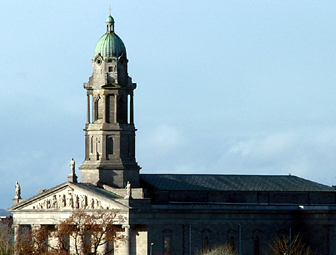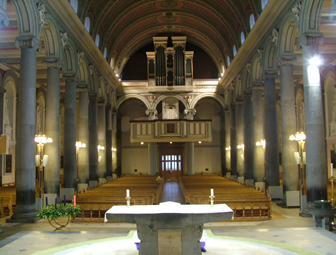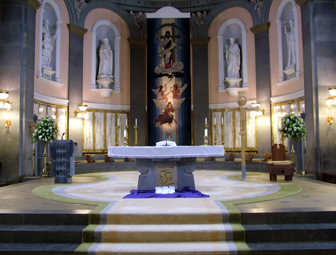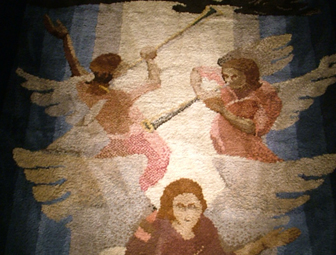The official
name of our parish is Templemichael and Ballymacormack.
It was created in the late 1700s and so is of comparatively
recent origin in an Irish context. There had also
been a Dominican Friary in the town of Longford, founded
in the early 1400s. The two distinct parishes of Templemichael
and of Ballymacormack had been linked to other surrounding
parishes in the diocese before the current parish
was formed. Templemichael had previously been listed
with the parish of Clonguish, and had links with Moydow
and Killoe parishes at later times. Ballymacormack
had a long connection with the parish of Killashee
dating back to at least the early 1500s and in the
1700s was joined with Moydow for a time.

St. Mel’s Cathedral
The Cathedral
is named in honour of St. Mel, who died around the
year 487/488, a contemporary of St. Patrick, and first
Bishop of Ardagh. The foundation stone of the Cathedral
was laid on 19 May, 1840 by Bishop O’Higgins,
just before the start of the Great Famine which was
to cause so much misery and death over the following
decade. The building as a result was delayed and the
Cathedral did not open for worship until 1856, by
which time John Kilduff had become bishop of the diocese.

The Entrance
Lobby and 200 foot high Bell Tower, designed by John
Bourke, were completed in 1863. The portico at the
front with six large 37 foot high columns, designed
by George Ashlin, was added later during the years
1889-1893. At the top of the columns there is a triangular
piece which is known in architecture as a tympanum.
Within this there is a large scene sculpted by George
Smyth depicting the consecration of St. Mel as Bishop
of Ardagh by St. Patrick. On top of the tympanum three
statues stand out against the skyline, one at each
side depicting St. Mel and St. Ciaran, patrons of
Ardagh and Clonmacnois respectively, and in the center
a statue of the Sacred Heart.
St. Mel’s
Cathedral was solemnly consecrated on 23 May 1893,
exactly 53 years after the foundation stone was laid.
The bishop at the time was Bartholomew Woodlock.

The inside
of the Cathedral is a simple but majestic style. The
Cathedral is constructed like many churches in the
shape of a cross. This cruciform shape has a long
central nave from the front door to the altar –
the roof of the nave as is tradition rises higher
than the two aisles on either side. The nave of the
Cathedral is flanked by six columns on either side.
The sanctuary at the top of the Cathedral was renovated
in 1975 after the Second Vatican Council. It was a
controversial change at the time and many in the town
who knew the Cathedral as it was lament its passing
to this day. Those who know only the present layout
find a welcoming space that is still most beautiful.
A tapestry designed by Ray Carroll and made by Killybegs
Carpets is located at the back of the altar and represents
the Coming of Christ in Glory.

As you face
the altar to the right are two chapels, firstly the
Blessed Sacrament altar with a Ray Carroll backdrop
depicting Jesus after his Resurrection at table with
two disciples whom he has accompanied on the road
to Emmaus. Further to the right is the Mortuary chapel
with a representation of the Pietà. To the
left-hand side of the sanctuary you will see Our Lady’s
altar and the Holy Family chapel. There are very detailed
and beautiful stained-glass windows by the internationally-acclaimed
artist Harry Clarke (1889-1931) at the end of the
side chapels. On the St. Mel’s College side
there is a depiction of the Resurrected Christ and
on the presbytery side there is a representation of
St. Anne, mother of the Blessed Virgin Mary. These
two windows are beautifully lit up at different times
of the year by the rising and setting sun. 1983 saw
the completion of the new Choir Gallery and the installation
of the new Pipe Organ by Kenneth Jones of Bray.

St. Mel
Saint Mel died
in 488. He is said to have been a Briton who came
to Ireland with Saint Patrick, his uncle, with whom
he worked until he was ordained in Ardagh. He is one
of the earliest Irish saints and gave the religious
veil to Saint Brigid. He is, along with St Ciaran
of Clonmacnois, the patron saint of the Catholic diocese
of Ardagh and Clonmacnois, and is commemorated in
the name of the Cathedral church of the diocese in
Longford.
